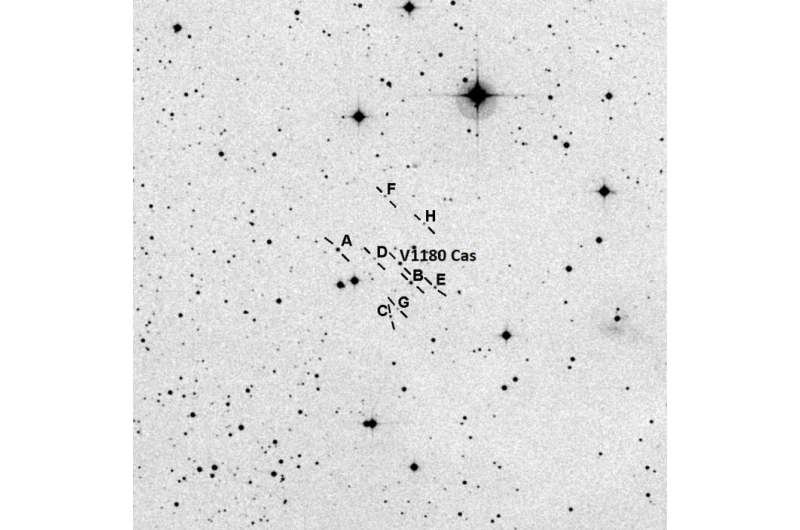V1180 Cas and comparison stars. Credit: Mutafov et al., 2022.
Bulgarian astronomers have performed long-term optical photometric observations of a young variable star known as V1180 Cas. Results of the observational campaign deliver essential information about the variability of V1180 Cas, shedding more light on the nature of this source. The study was published October 18 on arXiv.org.
Detecting and studying variable stars could offer important hints into aspects of stellar structure and evolution. Investigation of variables could be also helpful for a better understanding of the distance scale of the universe.
At a distance of some 1,950 light years, V1180 Cas is a young variable pre-main sequence (PMS) star associated with the dark cloud Lynds 1340 in the star forming region in the constellation Cassiopeia. Previous observations of V1180 Cas have detected a variability with an amplitude of about 6 mag, suggesting that it may be an eruptive young stellar object. However, further investigation of V1180 Cas has found that its variability differs from that of the eruptive PMS stars of FU Ori (FUor) and EX Lupi (EXor) type.
Therefore, in order to determine the true nature of this star, a team of astronomers Asen Mutafov of the Institute of Astronomy with the National Astronomical Observatory in Sofia, Bulgaria, took a closer look at the variability of this object. For this purpose, they employed three telescopes of the Rozhen National Astronomical Observatory in Bulgaria and one telescope Skinakas Observatory in Greece.
"Our data from VRI CCD photometric observations of the star are collected from September 2011 to February 2022," the researchers wrote in the paper.
The observations found that V1180 Cas showcases very strong photometric variability with large amplitude variations—up to 5 mag. In general, the I-band brightness of the star is kept in the range of 15–16 mag most of the observed time. However, there are some changes in brightness with small amplitudes, which is characteristic for T Tauri stars.
The photometric data also show another type of variability of V1180 Cas—deep declines in brightness for which no periodicity is observed. All in all, the astronomers identified four deep minimums in brightness in the light curve and the long-term light curve of this star turned out to be similar to that of other low-mass young stars exhibiting typical UXor variability.
Furthermore, the collected multicolor photometric data shows the typical for UXors color reversal during the minimums in brightness. This, according to the astronomers, is a manifestation of the so-called "blueing" effect—when the color of the star gets bluer in the minima of its brightness.
Summing up the results, the researchers concluded that the new findings confirm their initial assumptions regarding the mechanism behind the variability of V1180 Cas.
"In our previous paper (Mutafov et al. 2019), we concluded that the photometric properties of V1180 Cas can be explained by a superposition of highly variable accretion from the circumstellar disk onto the stellar surface and occultation from circumstellar clumps of dust, planetesimals or from other features of the circumstellar disk. The new observational data confirms this conclusion," the authors of the paper explained.
More information: Asen Mutafov, Evgeni Semkov, Stoyanka Peneva, Sunay Ibryamov, Long-term Photometric Study of the Pre-main Sequence Star V1180 Cas. arXiv:2210.09660v1 [astro-ph.SR], arxiv.org/abs/2210.09660
© 2022 Science X Network
























